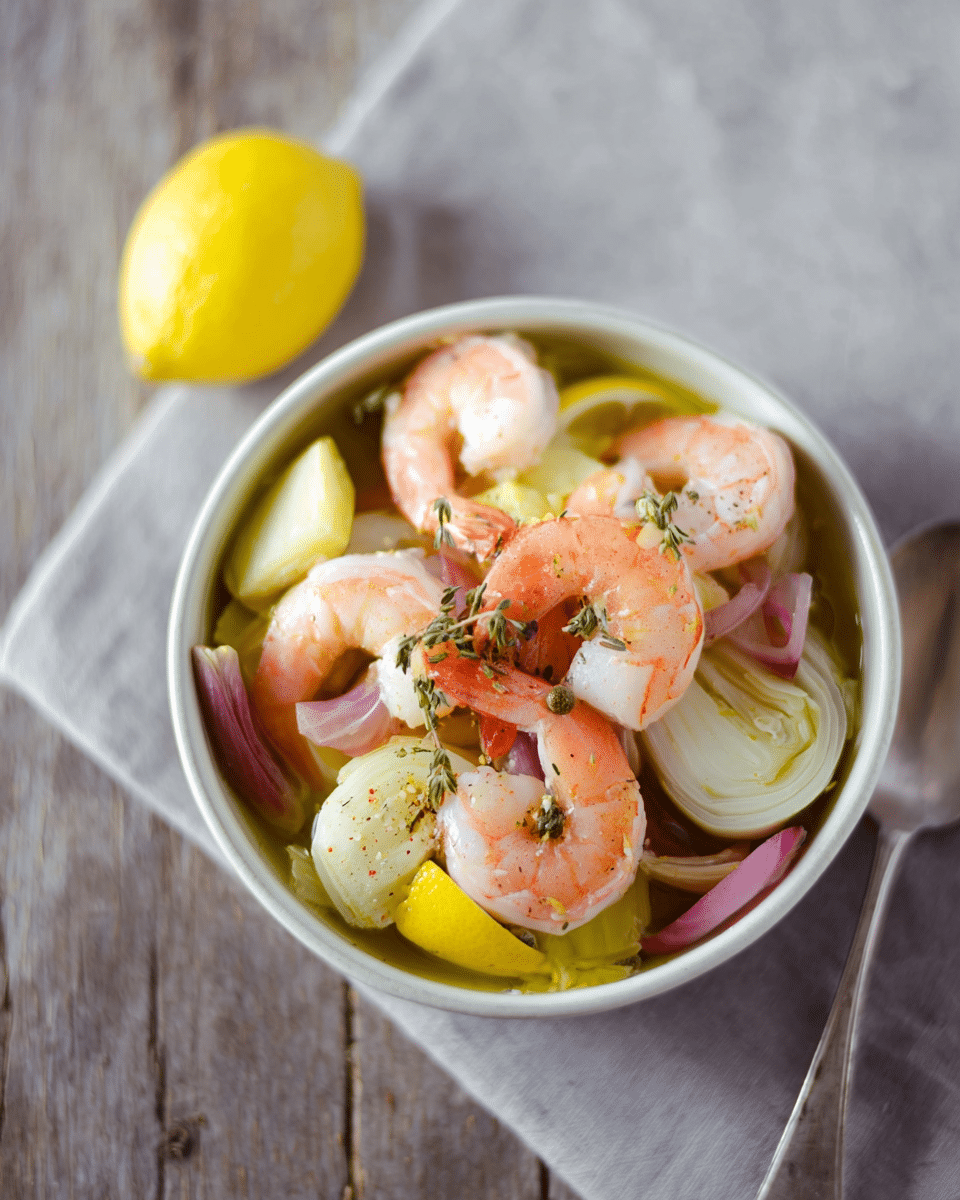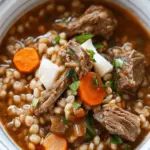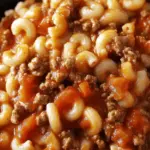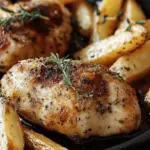The classic Southern-style Pickled Shrimp is an appetizer that’s as beautiful to look at as it is satisfying to eat. Poached shrimp are layered with aromatic herbs, lemon slices, and thinly sliced fennel in a jar, then bathed in a tangy apple cider vinegar and olive oil brine.
Let the shrimp marinate overnight to develop a bold and complex flavor profile. It’s the perfect make-ahead solution for cocktail parties, potlucks, or summer brunches. Serve it chilled with crackers, toothpicks, or on a bed of greens for a light and zingy salad starter.
Full Recipe:
-
1 rib celery, cut into 2-inch lengths
-
1 medium red onion, thinly sliced (divided)
-
1 lemon, sliced into very thin rounds (divided)
-
Salt, to taste
-
4 cups water
-
1 pound raw shrimp (12 to 20 count), peeled and deveined, tails intact
-
1/2 bulb fresh fennel
-
A few sprigs fresh thyme
-
1 garlic clove, halved
-
2 tablespoons capers with juices
-
2 teaspoons mustard seeds
-
1/2 cup apple cider vinegar
-
1/2 cup olive oil (or more if needed)
-
1 teaspoon crushed red pepper
Directions:
-
In a large saucepan, add the celery, half the red onion, half the lemon slices, a pinch of salt, and water. Bring to a boil.
-
Cover and reduce the heat to low. Simmer for 5 minutes.
-
Add the shrimp, immediately remove from heat, and cover again. Let stand for 5 minutes until shrimp are pink.
-
Trim fennel fronds and thinly slice the fennel bulb.
-
In a 1-quart jar, layer shrimp, remaining lemon slices, remaining red onion, sliced fennel, fennel fronds, thyme, garlic, capers, and mustard seeds. Discard cooking liquid.
-
Combine vinegar and oil, then pour into the jar until the shrimp are submerged. Add more oil if needed.
-
Seal the jar and refrigerate for at least 24 hours or up to 3 days.
-
Before serving, let it come to room temperature for 30 minutes. Spoon into a bowl and serve with toothpicks.
Prep Time: 10 minutes | Cooking Time: 10 minutes | Total Time: 20 minutes (plus 24 hrs chilling)
Kcal: 238 kcal | Servings: 6 servings
What Is Pickled Shrimp?
Pickled shrimp is a tangy, aromatic, and highly flavorful Southern-style appetizer made by marinating cooked shrimp in a spiced vinegar and oil mixture. While the concept of pickling seafood is not new, this particular preparation hails from the American South, especially along the Gulf Coast and Lowcountry regions, where fresh shrimp are abundant. This appetizer is celebrated for being not only delicious but also incredibly convenient: it’s made ahead of time, served chilled, and is an elegant yet simple dish that fits seamlessly into a wide range of occasions, from backyard gatherings to holiday feasts.
Unlike traditional hot shrimp dishes, pickled shrimp is served cold, making it an ideal summer or warm-weather appetizer. It also benefits from time—at least 24 hours in the fridge allows the flavors to meld and deepen. The result is a bright, herbal, and subtly spicy bite that feels both refreshing and indulgent.
Origins and Cultural Significance
Pickled shrimp holds a special place in the Southern culinary tradition. Its lineage traces back to various global influences, notably escabeche—a method of marinating or pickling seafood in vinegar, often found in Caribbean, Spanish, and Portuguese cuisines. Through migration and adaptation, this preservation method made its way to the Southern United States, especially in coastal regions such as Charleston, Savannah, and parts of Louisiana.
In the South, pickled shrimp was often a staple at cocktail parties and Sunday luncheons. It symbolized hospitality and ease—something that could be made in advance, looked beautiful when served, and was packed with flavor. Today, it continues to be a beloved recipe, passed down through generations and adapted with contemporary ingredients and spices.
Flavor Profile and Texture
The first thing most people notice about pickled shrimp is the vibrant appearance—plump, pink shrimp layered with translucent slices of lemon, slivers of red onion, fennel fronds, mustard seeds, thyme sprigs, and bits of garlic. But it’s the flavor that keeps people coming back.
At its core, pickled shrimp is tangy and zesty. The apple cider vinegar gives it a mild sharpness, while olive oil smooths things out with a rich finish. The mustard seeds and crushed red pepper introduce complexity and a touch of heat, while capers add a briny depth. The lemon slices not only look beautiful in the jar but infuse the mixture with citrusy brightness that complements the sweet flesh of the shrimp.
The texture is equally appealing: tender, perfectly poached shrimp that still have a slight snap to them. The thinly sliced fennel and onion add a pleasant crunch and subtle bite, balancing the softness of the shrimp.
Why It’s a Great Make-Ahead Appetizer
One of the biggest advantages of pickled shrimp is its make-ahead nature. In fact, it’s better when prepared a day or two in advance. Once packed into a jar and sealed, the shrimp slowly absorb the flavors of the pickling liquid. This allows the dish to mature in the refrigerator, so by the time it’s served, every element is perfectly infused.
For anyone entertaining guests, this is a dream come true. It frees up time on the day of the event, requires zero reheating, and looks impressive with minimal effort. Whether served in a bowl with toothpicks or layered elegantly in cocktail glasses, it delivers on both taste and presentation.
Versatility and Serving Ideas
Pickled shrimp can be served in many different ways. The most traditional method is simply placing them in a shallow bowl, chilled, with toothpicks or small forks for easy grabbing. But that’s just the beginning.
You can serve it over a fresh green salad to add protein and a punch of flavor, or as part of an appetizer platter with other marinated vegetables, olives, and cured meats. It also pairs beautifully with crusty bread or crackers—especially cocktail rye or crostini—alongside creamy spreads like Boursin cheese or aioli.
For something a bit more upscale, you can place individual shrimp over cucumber rounds or endive leaves for a passed hors d’oeuvre. Or try placing one or two on a slice of baguette spread with olive tapenade or herbed cream cheese. However you choose to serve it, pickled shrimp brings a burst of brightness that complements a variety of other flavors and textures.
Regional Variations and Adaptations
While the core ingredients of pickled shrimp remain consistent—shrimp, vinegar, oil, and aromatics—many cooks like to adapt the recipe to reflect regional preferences or personal tastes.
In Texas, for example, it’s common to add chopped cilantro and lime juice for a Southwestern twist. Some recipes incorporate jalapeños or even Scotch bonnet peppers for more heat, influenced by Caribbean cuisines. In Louisiana, a bit of Creole mustard or hot sauce might be added for an extra kick.
You can also swap in different herbs, such as dill or tarragon, or experiment with flavored vinegars. Even the vegetables are customizable—radishes, carrots, or cucumbers can all be added for more crunch and color.
Storage and Safety Considerations
Although the term “pickled” suggests long-term preservation, this recipe is more of a quick pickle or marinade. It’s essential to keep pickled shrimp refrigerated and to consume them within 3 to 5 days for optimal freshness and safety. The olive oil may solidify when chilled, but it will return to a liquid state once brought to room temperature. Always make sure the shrimp are fully submerged in liquid to maintain their quality.
If you’re planning to serve them for a party, take the jar out of the refrigerator about 30 minutes beforehand to allow the oil to liquefy and the flavors to open up fully.
Health Benefits of Pickled Shrimp
Pickled shrimp isn’t just delicious—it’s also a relatively healthy option for an appetizer. Shrimp is naturally low in calories and rich in protein, providing essential nutrients such as iodine, selenium, and vitamin B12. The use of olive oil adds heart-healthy monounsaturated fats, while the vinegar offers potential digestive benefits.
The absence of heavy sauces, frying, or added sugars makes pickled shrimp a light yet satisfying dish. It’s also naturally gluten-free and can be part of low-carb, paleo, or even Mediterranean-style eating plans.
Just be mindful of the sodium content, especially if you’re watching your salt intake. Some pickling recipes can be high in salt due to the brine and added capers, but this can be adjusted to your dietary needs.
Presentation Tips for Impressing Guests
Presentation plays a big role in the appeal of pickled shrimp. Use a clear glass jar or serving dish to show off the layers of shrimp, lemon slices, herbs, and aromatics. The visual impact alone is enough to make people curious—and once they taste it, they’ll be hooked.
If serving on a buffet table, place the jar on a small plate surrounded by lemon wedges, sprigs of fresh thyme, and a few slices of crusty baguette. For passed hors d’oeuvres, consider placing individual shrimp in small tasting spoons with a tiny sliver of fennel and a drop of aioli. Don’t forget the chilled white wine or a light beer to accompany the briny goodness.
Conclusion: A Timeless Classic for Modern Gatherings
Pickled shrimp is a dish that beautifully bridges the gap between tradition and modern convenience. It speaks to Southern hospitality, global culinary history, and smart entertaining all at once. Its bold, zesty flavor and elegant presentation make it a standout on any table, while its simplicity and flexibility ensure it never goes out of style.
Whether you’re planning a formal dinner, a laid-back barbecue, or a festive holiday gathering, this marinated shrimp dish deserves a place on your menu. Once your guests taste it, you’ll find yourself being asked for the recipe time and time again—and you’ll be glad it’s such an easy one to share.






